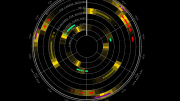
NDN leverages evidence about what has worked on the Internet over the past 30-plus years. Credit: UCLA newsroom
UCLA will host a consortium of universities and leading technology companies on September 4 and 5 to promote the development and adoption of Named Data Networking (NDN) – an emerging Internet architecture that promises to increase network security, accommodate growing bandwidth requirements, and simplify the creation of increasingly sophisticated applications.
The consortium is being organized by a team of NDN researchers at the UCLA Henry Samueli School of Engineering and Applied Science. Other founding academic members of the NDN project are UC San Diego, Colorado State University, the University of Arizona, the University of Illinois Urbana–Champaign, the University of Memphis, the University of Michigan, and Washington University in St. Louis.
The first NDN community meeting will be held September 4 and 5 at UCLA’s School of Theater, Film and Television, which has played a key role in envisioning the future of human communication over NDN since the project’s origins in 2010.
Among the industry partners planning to participate are Verisign, Cisco Systems, and Panasonic. They will be joined by representatives from Anyang University (Korea), Tongji University and Tsinghua University (China), the University of Basel (Switzerland) and Waseda University (Japan).
“Collaboration with industry is an important step toward bringing Future Internet Architectures out of the laboratory and into the real world,” said Darleen Fisher, the NSF program officer who oversees the Future Internet Architectures program supporting NDN.
The NDN team’s goal is to build a replacement for Transmission Control Protocol/Internet Protocol, or TCP/IP, the current underlying approach to all communication over the Internet. The consortium aims to generate a vibrant ecosystem of research and experimentation around NDN; preserve and promote the openness of the core NDN architecture; and organize community meetings, workshops, and other activities.
“NDN has built significant momentum through a commitment to an open approach that aims to limit proprietary intellectual property claims on core elements of the architecture,” said Lixia Zhang, UCLA’s Jonathan B. Postel Chair in Computer Science and a co-leader of the project.
“This has spurred substantial interest from both academia and industry. Our goal with the consortium is to accelerate the development of architecture that will lift the Internet from its origins as a messaging and information tool and better prepare it for the wide-ranging uses it has today and will have tomorrow,” Zhang said.
NDN leverages empirical evidence about what has worked on the Internet and what hasn’t, adapting to changes in usage over the past 30-plus years and simplifying the foundation for the development of mobile platforms, smart cars, and the Internet of Things — in which objects and devices are equipped with embedded software and are able to communicate with wireless digital networks.
Since 2010, the National Science Foundation’s Future Internet Architectures program has provided more than $13.5 million to the NDN project led by UCLA, including a grant of $5 million that was announced in May.
“Cisco Systems is enthusiastic about the formation of the NDN community,” said David Oran, a Cisco Fellow and a pioneer in Internet Protocol technologies. “It will help evolve NDN by establishing a multifaceted community of academics, industry, and users. We expect this consortium to be a major help in advancing the design, producing open-source software, and fostering standardization and adoption of the technology.”
The NDN project is co-led by Zhang and Van Jacobson, a UCLA adjunct professor and member of the Internet Hall of Fame. UCLA became the birthplace of the Internet in 1969, when a message from the lab of UCLA computer science professor Leonard Kleinrock was sent to the Stanford Research Institute — the first-ever message transmitted over the network that later became known as the Internet.









Be the first to comment on "Consortium to Focus on Developing a New Architecture for the Internet"